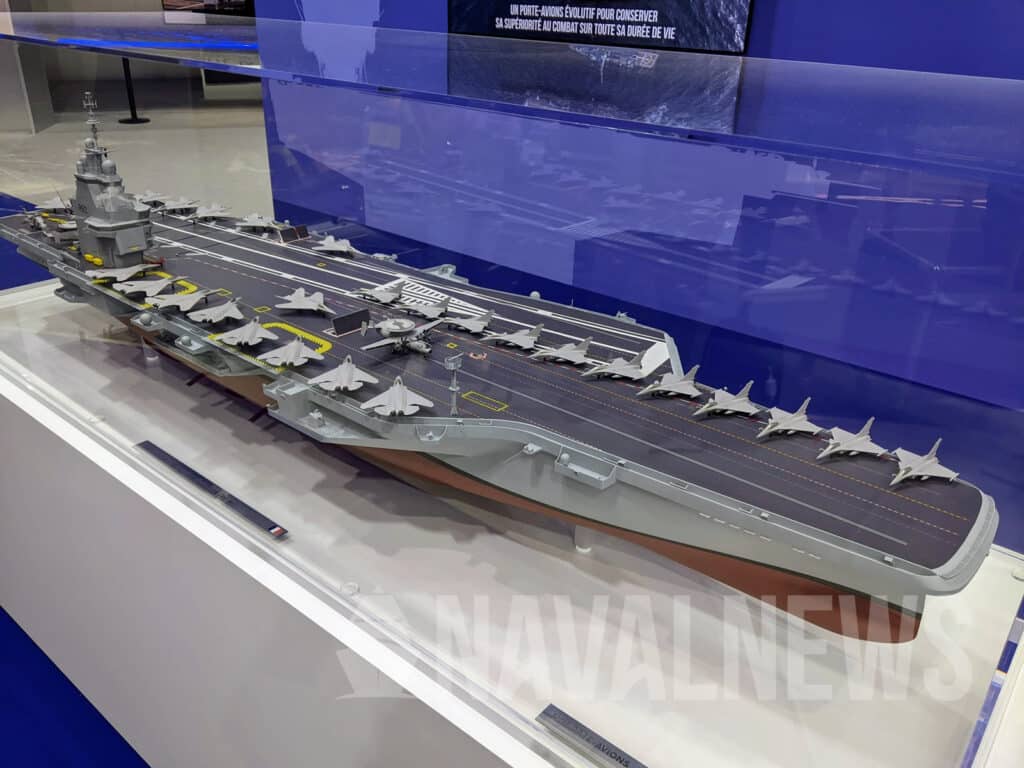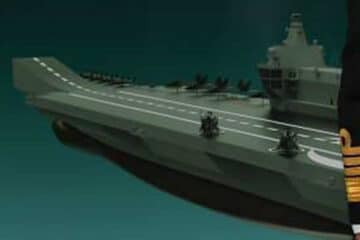Naval News flew aboard USS Gerald R Ford while the carrier was off the coast of France, participating to exercise Silent Wolverine.
In this video I briefly introduce some of the aircraft present on deck. I then meet with the Commanding Officer, Captain Paul Lanzilotta, to learn about the Ford.
Captain Lanzilotta introduces USS Gerald R Ford (CVN 78) as the “U.S. Navy’s newest, biggest and baddest warship”.
USS Gerald R Ford’s basic specifications
Asked by Naval News about the specifications of the ship, CAPT Lanzilotta explained: “The crew assigned to the ship is 2,700 personnel. That’s just the ship’s company. The airwing adds about 1,700 people on top of that. And we would embark normally 200 to 300 additional folks for the strike group staff and destroyer squadron staff. The ship is almost the same as the Nimitz-class […] About 1,107 feet long [Ed. Note: 337 meters], displaces about 96,000 tons, our height above the water is about 220 feet and we draft about 40 feet [Ed. Note: 12 meters] in the water depending on our loading, how many aircraft. Right now we have got just over 50 aircraft on the ship. It is a really good complement”.

Ford compared to Nimtz
Asked about the differences between the Nimitz-class and the Ford-class, the commanding officer said: “So the differences are significant behind the outer view of the ship. If you look at the ship, it’s about the same length and displaces about the same amount of tonnage. The propulsion plant is new, more modern requires less manning that helps us save costs in the long run. “
The Electromagnetic Aircraft Launch System is newer, more modern and requires less maintenance over the long haul. It is able to launch aircraft over a broader mission span in terms of lighter aircraft, potentially unmanned aircraft in the future, heavier aircraft, potentially newer aircraft that we develop in the future, while meeting the mission requirements and putting a little bit less stress on those aircraft because we very precisely launch the aircraft off the front of the ship at just the right speed. The older system is a lot more rudimentary. The steam catapult system is awesome. It’s very reliable, but it is technology that’s about 70 or 80 years old. When you open the launch valve on a steam catapult you get what you get. And we always add speed we don’t we don’t under calculate that. So that puts stress on the aircraft. And less stress on the aircraft means fewer costs to maintain and keep those aircraft flying over the long haul. So that’s just a couple of examples of our technology.
Captain Paul Lanzilotta
“Our advanced weapons elevators are completely redesigned to move ordinance a lot more effective more quickly. The design of the ship is different if you just look at the Gerald R Ford, where we’re standing here on the flybridge is in the island house. That island is further aft on our ship, then on the older ships that allows for more room forward of the island to move aircraft around, taxi them clear of the landing area once they recover, and then refuel and rearm. So we anticipate the ship being a lot more efficient at the job over the again over the long haul.”
Ford’s in-deck fueling stations

Naval News then asked CAPT Lanzilotta about another new technology or feature of the Ford: The in-deck fueling station:
“I just flew the Hawkeye a couple of days ago. There’s six in-deck fueling stations arranged on the flight deck. Four along what we call the fighter line. And then two further forward. The Hawkeye that I flew was able to land from its previous mission, taxi clear the runway, position itself ready to go for the next event, turn off one of the engines and was refueled in four minutes as I waited to get in the airplane and go flying again. Much more efficient than having to drag the fuel hose all the way across the flight deck to refuel. It’s a great investment and a design change. It seems like a small design change but a lot of effort goes into that. And I think turns the aircraft around a lot more quickly. It’s a little bit like a Formula One Stop…”
Captain Paul Lanzilotta
Maintaining Interoperability with the French Navy

Naval News asked CAPT Lanzilotta about interoperability and how EMALS will maintain interchangeability between the US Navy and France’s future aircraft carrier (known as PA-Ng):
“I anticipate there to be great interoperability between the ships, just as there has been in the past. We have launched and recovered Rafale aircraft on the older ships. With EMALS, if that’s common in the new carrier for the French Navy, then I would anticipate that same kind of interoperability between aircraft. I can tell you that the conversations and the relationships between our program offices are very good. And that’s always a good thing. It is kind of where we build the foundation for our cooperation is in those relationships. And it has been really good.”
Captain Paul Lanzilotta
Check out our Part 1 coverage aboard USS Gerald R. Ford (CVN 78) at this link:





